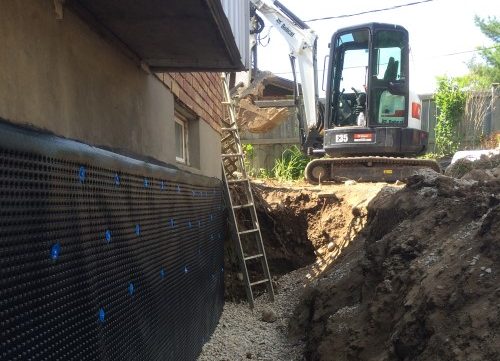There are many misconceptions surrounding basement waterproofing. Waterproofing your basement is an important part of home maintenance. Let’s explore if it’s possible to do so without digging. Proper waterproofing not only protects your basement from water damage but, more importantly, safeguards your property and your family’s health.
One misconception is that painting a sealant on interior basement walls is an effective method of waterproofing. In reality, this method is ineffective.
Exterior waterproofing and gravity drainage are the best way to waterproof your basement and are recognized by the International Building Code as efficient in preventing structural damage. Polymers used in exterior waterproofing can last thousands of years, making it the best option.
- Exterior waterproofing requires excavation to the foundation footing and completely eliminates water and moisture penetration, saving you thousands of dollars in the long run.
Sump pumps drain away most interior water but cannot eliminate groundwater seepage from cracks in foundation walls.
Interior waterproofing (painted sealant) is not actually waterproofing but is commonly used to control basement water levels. Sealing a wall on the inside can actually speed up wall deterioration and cause structural damage, wood rot, and health issues.
- The primary function of a sealant is to create a barrier between the wall and the water.
- However, this method fails to address the underlying issue that is causing water infiltration in the first place.
- When you paint a sealant on the interior walls, it only stops the water from seeping through the surface.
- The water that has already penetrated the walls will remain trapped inside, causing further damage over time.
- This will lead to mould growth and a musty odour, which will eventually affect the air quality of your basement.
Moreover, the sealant’s coating can peel off over time, exposing the wall to moisture, which can lead to further damage. Once the coating has peeled off, the sealant becomes ineffective, and you will have to repeat the process all over again.
Painting a sealant on interior basement walls can also create a false sense of security, leading to more severe water damage over time. When you do not address the root cause of water infiltration, the problem will persist, causing more damage and expense in the long run.
The best way to waterproof your basement is to address the source of water infiltration.
- This can involve excavating around the foundation and applying a waterproofing membrane on the exterior walls.
- It may also require the installation of a sump pump or a
- French drain to prevent water from accumulating around the foundation.
Painting a sealant on interior basement walls is not an effective method of waterproofing. It only provides a temporary solution and does not address the underlying problem. If you want to protect your basement from water damage and ensure the safety and health of your family, it is best to address the root cause of water infiltration and seek the help of a professional waterproofing contractor.
It’s important to note that there is no true waterproofing without excavating and digging to the foundation’s footing. Only exterior waterproofing can prevent intense structural damage to a building or home.
For those in the London, Ontario area, Best Plumbing and Drainage Contractors has been providing the correct type of waterproofing for decades. Our exterior waterproofing and drainage services have proven to be efficient in preventing water and moisture penetration, ultimately saving our clients thousands of dollars in the long run.
If you’re experiencing seepage or dampness through your business or home’s walls, Best Plumbing and Drainage Contractors can provide the solution you need for proper waterproofing. Don’t hesitate to call us with your concerns and questions at (519) 438 6565 or contact us online.
This post was written by Allan
April 6, 2023
Back to Blogs

